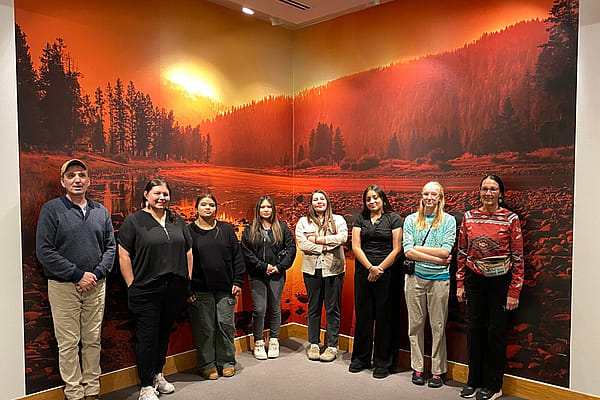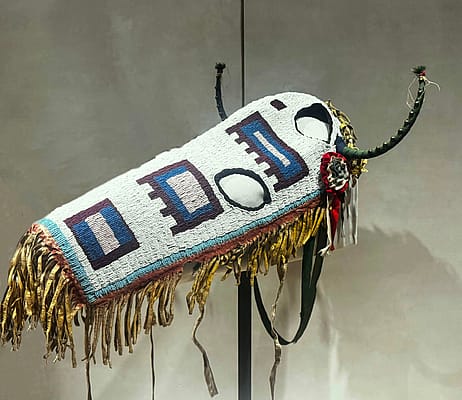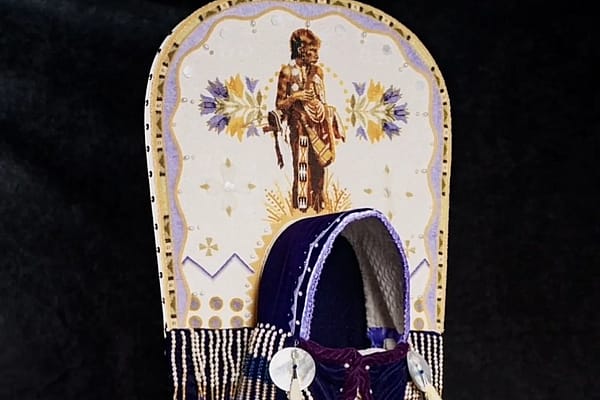Recording the Spirit of a Culture – Points West Online
Originally published in Points West magazine
Summer 2000
Recording the Spirit of a Culture
By Rebecca S. West
Curator of Plains Indian Cultures and the Plains Indian Museum
Frances Densmore is known in the field of anthropology as a dedicated ethnomusicologist who recorded and preserved over three thousand Indian songs from 1905 to 1940. An accomplished pianist, Densmore had formal schooling in music, and was drawn to the field of ethnomusicology after reading reports by fellow anthropologist Alice Fletcher. Early, independent research ventures were amongst the Sioux near Red Wing, Minnesota and the Chippewa of the White Earth Reservation. By 1907 Densmore would embark on numerous research projects funded by the Bureau of American Ethnology, the Historical Society of North Dakota, and later, the Smithsonian. Densmore ultimately worked with tribes from all regions of the United States from the Southwest, to British Columbia, and Florida. Densmore described her life’s work as recording “the spiritual life of a race.” She came to realize that Indian music is fundamental to Indian culture, profoundly intertwined with religion, spirituality, and daily life. By studying the music of these cultures, she aided the preservation and continuation of disappearing cultural traditions.
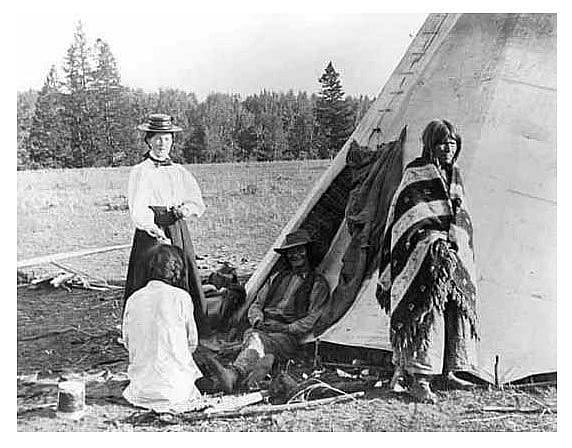
When we hear music that is not from our own culture, it can seem foreign, and unnatural. An anthropological explanation notes, “In music, as well as in art, our culture largely determines what we consider acceptable variations, what we say has ‘meaning’ to us. Even a trained musicologist, listening for the first time to music of a different culture, will not be able to hear the subtleties of tone and rhythm that members of the culture hear with ease.” Densmore had additional challenges as she had visited tribes in remote locations, often living with them for days or weeks at a time. Much of the translating had to be done through an interpreter. Her recording equipment was unwieldy, but essential. Indians had no written form of music; songs were passed through individuals and generations. Initially she used an Edison Home Phonograph, and later a graphophone and a dictaphone.
Frances Densmore’s research consisted of three main phases: Recording the songs and collecting related artifacts and information from Indian subjects; transcribing the songs into musical notes; and, analyzing and publishing findings. Densmore realized the importance of collecting musical instruments, associated artifacts, and even plants and herbs as a method of interpreting songs in their cultural context, especially in the case of ceremonial or healing songs. She concluded that musical instruments used by North American Indian tribes vary greatly, as does their music. One exception—the gourd rattle—was widely used. Densmore collected hide drums from the Sioux, plank or box drums from Northwest Makah, flutes from the Winnebago of the Great Lakes regions, and various types of whistles and rattles. Although instruments were collected as meaningful artifacts, Densmore did not overemphasize the role of instruments in comparison to music made by the Indian voice, “Instrumental music is used only as an accompaniment to singing among the Indians, except that the young men sometimes play a flute in the evenings and a whistle may be blown in ceremonies or in the treatment of the sick.” In Densmore’s estimation, the human voice was the most significant “instrument.”
While Densmore’s research among Indian tribes was scientifically based, she managed to grasp the elusive concept of spirituality while studying healing songs, dream or personal songs, and warrior’s songs. Her refusal to record the most sacred of songs illustrated her understanding and respect for Indian beliefs. Densmore was able to separate common misinterpretations of Indian songs, as a form of entertainment, from their spiritual and ceremonial nature:
…the terms ‘superstition’ and ‘witchcraft’ as well as words of highest spiritual import, were attached to Indian customs. These terms became permanent and, to a large extent, have influenced the White Man’s opinion of the Indian. Similarly the terms ‘music’ and ‘singing’ were applied to Indian performances. These did not please the White man, and there is still a reluctance to regard music as an important phase of Indian culture worthy of our consideration.
In her article “The Belief of the Indian in a Connection Between Song and the Supernatural,” Densmore articulately interpreted the Indian concepts of spirits and dreams in relation to songs. While songs in many cultures are written to or for a deity, Indian songs are received from spirits through dreams, or visions. When a song is transferred in this manner, it becomes the recipient’s possession, or “personal song.” A moving example is a personal song recorded by Densmore while she was working with the Pawnee. As a boy, a warrior named Eagle was frightened of thunder. The thunder spoke to him in a dream and told him not to be afraid. The warrior remembered the thunder’s song, which became his own:
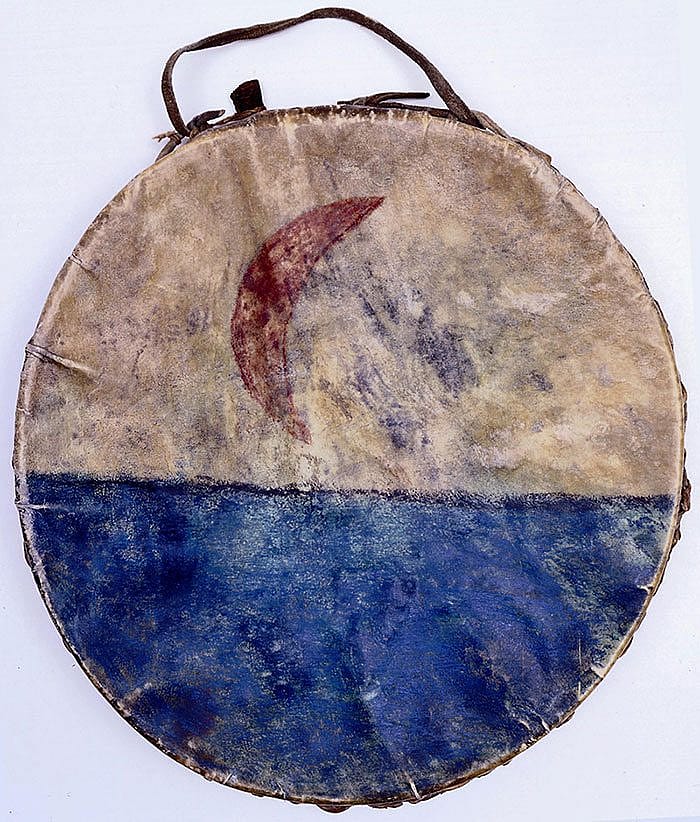
Beloved it is good,
He, the thunder, is saying quietly,
It is good.
As a grown man, Eagle would sing this song whenever he went to war as a source of courage and inspiration.
Densmore discovered the existence of a hierarchy of songs in the tribes she studied. Songs associated with men’s roles, such as warrior’s songs, or healing songs, were considered more significant than, for example, a lullaby or a woman’s lamenting song. Densmore did not trivialize the cultural significance of any song, and recognized each song as being part of a cultural tradition. However, she also appreciated a more romantic quality she called “the poetry of song.” The following Chippewa lullaby, Densmore noted, would have been sung in a low, soothing voice, using the syllables “way, way, way” in a mesmerizing rhythm.
Little baby, sleep,
Mother swings your hammock low;
Little birds are asleep in their nest.
Way, way, way, way, way,
Way, way, way, way, way, way, way.
Little baby with nothing to fear.
Lullabies and love songs did not have the spiritual impact or gravity of healing, warrior society, or other ceremonial songs, but were valued for their soothing qualities and as a form of expression. Such songs are also significant in outlining men’s and women’s responsibilities in Indian cultures.
To analyze all of Densmore’s data is a daunting task. For each song that was recorded and transcribed, Densmore produced a detailed chart of rhythm, tone, pitch, tempo and melody. She was able to formulate common characteristics for Indian music as a whole: songs usually begin with high notes and end in a low note; rhythm is more prominent than melody; and, music is based on vocal capabilities rather than on notes produced from a musical instrument. While songs were a valued part of cultural traditions, passed from one generation to the next, they were in danger of being lost: “…songs are rapidly passing away and are now a matter of tradition, which adds to the importance of preserving the old songs that have been handed down to the present generation, with the story of their origin.” Frances Densmore’s research has ensured, for future generations of Indian tribes, that traditional songs continue to be links to the past as well as celebrations of a vital present.
Bibliography:
- Ember, Carol R., and Melvin. Cultural Anthropology. New Jersey: Prentice-Hall, Inc., © 1996.
- Densmore, Frances. “The Study of Indian Music.” Smithsonian Annual Report for 1941 (Publication 3651). Washington, D.C., 1941.
- Densmore, Frances. “Pawnee Music.” Bureau of American Ethnology, Bulletin 93. New York: Bureau of American Ethnology, 1929.
- Densmore, Frances. Poems from Sioux and Chippewa Songs. 1917.
- Densmore, Frances. Letter to Willard Rhodes of Columbia University. May 6, 1953.
Post 127
Written By
Nancy McClure
Nancy now does Grants & Foundations Relations for the Center of the West's Development Department, but was formerly the Content Producer for the Center's Public Relations Department, where her work included writing and updating website content, publicizing events, copy editing, working with images, and producing the e-newsletter Western Wire. Her current job is seeking and applying for funding from government grants and private foundations. In her spare time, Nancy enjoys photography, reading, flower gardening, and playing the flute.

